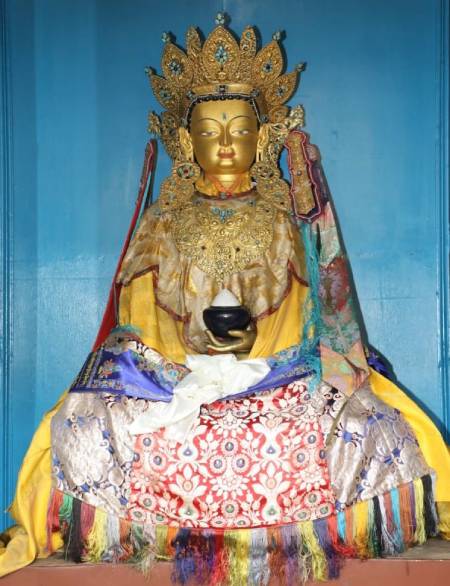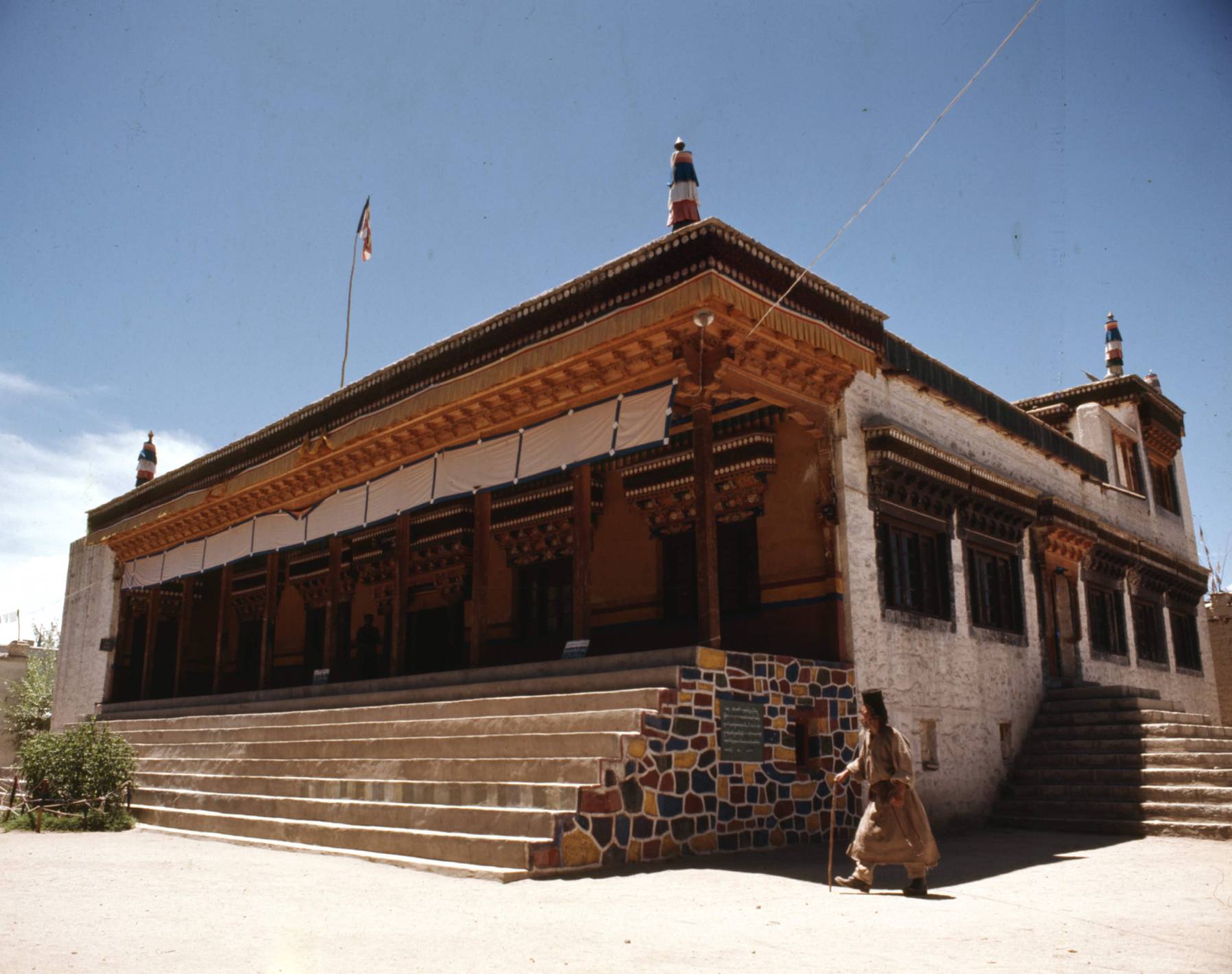

Chowkhang Vihara Leh is the seat of the Buddha statue in the form of supreme emanation body of Buddhahood. It is a great centre of pilgrimage and the people of Ladakh, irrespective of their association to different sects or schools of Tibetan Buddhism of Nalanda tradition, own it as a centre where all come to seek refuge and circumambulate the seat of Chow-Shakya Muni.
The people of Ladakh, both monks and laity, traditionally went to Tibet on pilgrimage in olden times. They endured tremendous hardship while traversing the vast expanses of western Tibetan high altitude wilderness on foot for months to reach Tibet. The Chow Rinpoche of Lhasa used to be the primary focus of pilgrimage. However, this valued sanctum fell under Chinese occupation, making access more difficult. People of Ladakh felt highly deprived and decided to install a statue of Chow Rinpoche or Chow Shakyamuni at Leh itself after building a new Chowkhang as a replica of the Chowkhang Vihara of Lhasa.
A decision was made to allot land for the purpose in the heart of Leh. The present site was selected, which was traditionally part of the Ladakh Palace property forcibly acquired by the Dogras in 1865 CE for building government offices, specifically the District Commissioner's Office, Pratap Bhavan, constructed by Mehta Mangal in 1865. This site was previously known as Wazir Bagh. Bakula Rinpoche and the Ladakh Buddhist Association submitted an application for a land grant, which was approved by the Government of Jammu and Kashmir.
The foundation stone of the Chowkhang Leh monastery was laid by Bakula Rinpoche on the 11th day of the 4th month of the Tibetan calendar in 1957, during which Kachhen Eshey Tundup of Stok Omachikpa was the president of LBA. The construction was led by Sh Rafstan of the Sankar Jingser family as the head mason, while carpenter Stanzin from the Sheynam Koglug family handled the wooden work. Lakruk Tsewang Rigzin and Gelong Lobzang Chospel from the Koglug family served as overseers, responsible for the construction from start to finish. Sh Sonam Stobdan from the Lachumir family acted as secretary, while Lakruk Tsewang Rigzin also managed the accounts and Sh Tashi Tundup Chhali handled the finances as cashier. Hundreds of people from around Leh volunteered as laborers and brought stones from a nearby hillock called Khigu Brag.
Stakna Rinpoche launched a campaign all over Ladakh to collect donations and hence received contributions from many villages across Ladakh. Hemis monastery donated hundred beams of poplar tree which were transported on the Indus river from Martselang to Choglamsar bridge and then carried by householders from Leh to the construction site.
Sh Thinley of the Phyang Chhokon family crafted the altar for the Chow Rinpoche statue by carving wood, while Ven. Meme Konchok Chhubi of Phyang monastery painted it in the Dikung color tradition. The paintings on cloth depicting the twelve virtuous deeds of the compassionate one were created by Spon Tsering Wangdus of Nimoo Olthangpa and displayed on the inner walls of the assembly hall. The monastery is home to two small, four-foot-high silver-covered stupas donated by His Holiness Dudjom Rinpoche of the Nyingma tradition and Ven. Geshes Lobzang Tharchin of Gochag-pa of the Gelug tradition.
The devotees believe that pilgrimage to this Chow Rinpoche statue offers blessings and merits equal to those received at Chowkhang Vihara in Lhasa. The assembly hall houses a full set of Kangyur (Buddhavachana) volumes from the Narthang edition and another set copied from the original Kangyur at Stok Palace. Additionally, there are 130 volumes of various scriptures, including the "Astasahasrika Prajnaparamita" Sutra, on the shelves.
A copper statue of Chow Rinpoche was built at Lhasa and transported to Ladakh. Rev Lobzang Rigdol (of Lharjay family of Phey village), a monk from Spituk monastery, was sent to Lhasa to bring the statue, but he passed away in Tibet in 1961. Yeshesh Tundup from Nimoo Gonpapa family and Gelong Nawang Lobzang from Chuchot Lotupa house assumed responsibility for bringing the statue to Leh. They brought the statue in pieces to Ladakh where it was reassembled and gilded by Chilling Yokmapa Phutsog Spalzang and Gyastakpa Sonam Wangdus of Kaya village. Hundreds of devotees offered limitless precious metals such as gold, silver, lapis lazuli, coral, pearl, and so on for use as relics inside the statue (called "Zungs").
Under Ven. Yongzin Konchok Sonam's leadership, the LBA president, the statue was adorned with golden polish and variegated ornaments. When Ven. Yongzin Konchok took charge of the presidency, the LBA had only Rs 4,000. After allocating Rs 2,000 for room rent to Rubshow Goba and Rs 600 to Spon Tsering Wangdus, Nimoo Olthangpa for painting a thangka for Buddha Vihara, only Rs 1,400 and 20 tolas of gold remained for the statue's adornment. With donations from various quarters, the total cost for adorning the statue was around Rs 20,000, including goldsmith labor charges, and 52 tolas of gold were used. The task was completed by the 10th of the 4th Tibetan month in 1962. The statue was formally consecrated on the 15th day of the same month, a triple auspicious day marking the Buddha's birth, enlightenment, and Mahaparinirvana, celebrated by 300 monks and approximately 15,000 laypeople.